Leadership: Critical Analysis of Leadership and Organizational Success
VerifiedAdded on 2020/02/24
|6
|1010
|36
Essay
AI Summary
This essay offers a comprehensive analysis of leadership, exploring its multifaceted roles and impact on organizational success. It begins by defining leadership and highlighting its importance at various organizational levels, from top-level strategic planning to ground-level crisis management. The essay then delves into a critical examination of leadership theories, contrasting traditional approaches with the demands of the modern, competitive business landscape. It identifies common challenges faced by organizational leaders, such as external threats and the need for innovative strategies. Furthermore, the essay emphasizes the crucial relationship between effective leadership and organizational success, detailing how strong leadership fosters team management, strategic execution, and the achievement of organizational objectives. Finally, it underscores the importance of leadership development plans and the implementation of effective strategies to drive organizational growth and sustainability, concluding that leadership is a fundamental driver for organizational success.
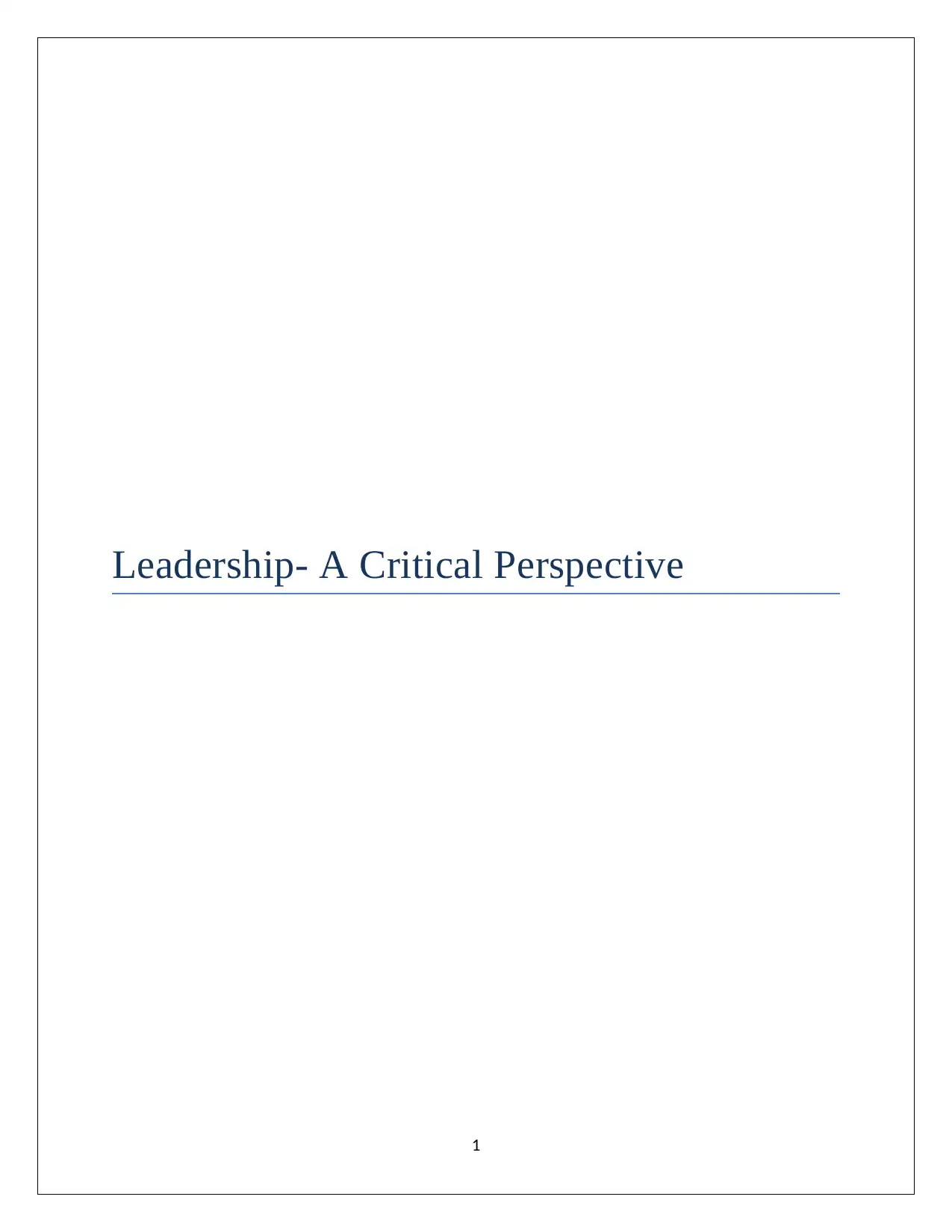
Leadership- A Critical Perspective
1
1
Paraphrase This Document
Need a fresh take? Get an instant paraphrase of this document with our AI Paraphraser
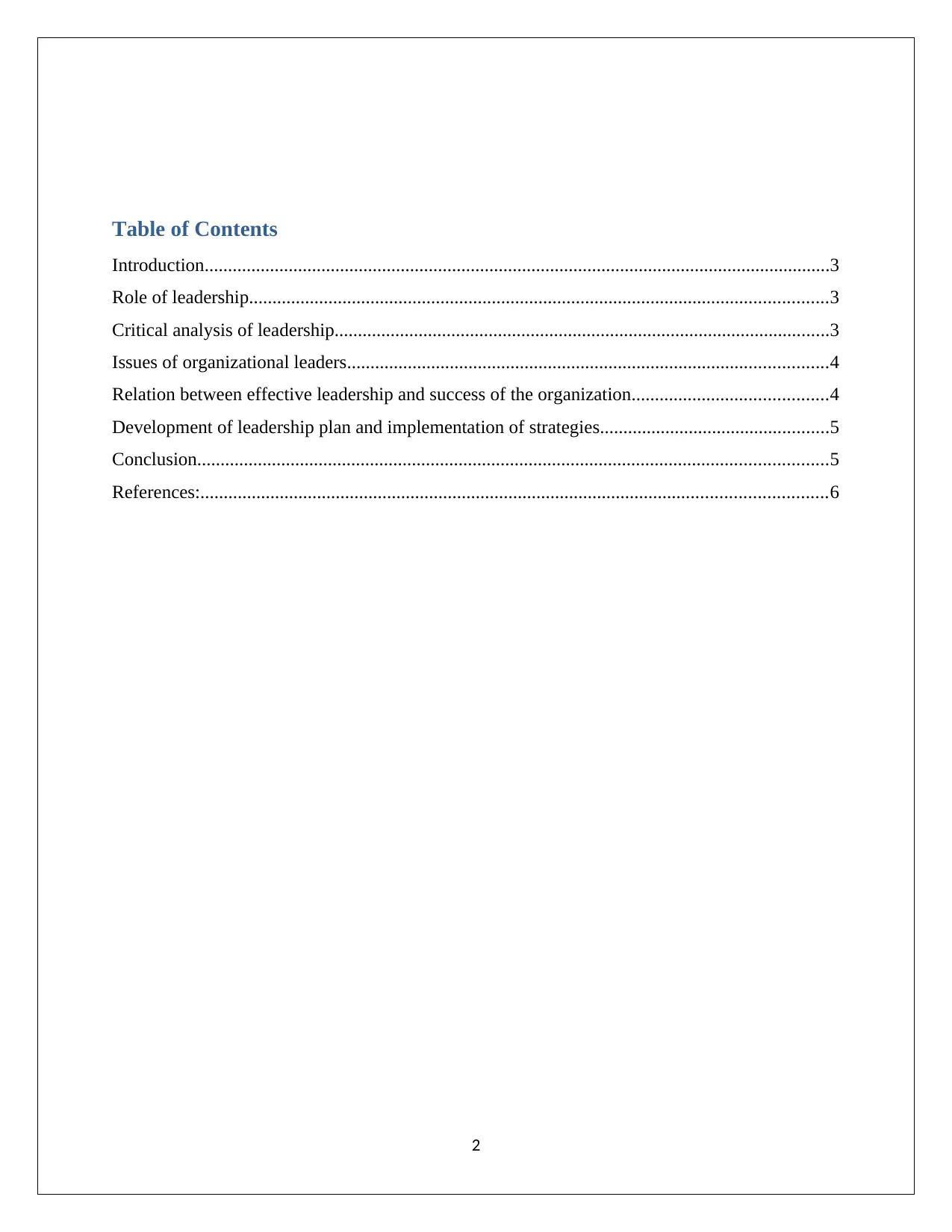
Table of Contents
Introduction......................................................................................................................................3
Role of leadership............................................................................................................................3
Critical analysis of leadership..........................................................................................................3
Issues of organizational leaders.......................................................................................................4
Relation between effective leadership and success of the organization..........................................4
Development of leadership plan and implementation of strategies.................................................5
Conclusion.......................................................................................................................................5
References:......................................................................................................................................6
2
Introduction......................................................................................................................................3
Role of leadership............................................................................................................................3
Critical analysis of leadership..........................................................................................................3
Issues of organizational leaders.......................................................................................................4
Relation between effective leadership and success of the organization..........................................4
Development of leadership plan and implementation of strategies.................................................5
Conclusion.......................................................................................................................................5
References:......................................................................................................................................6
2
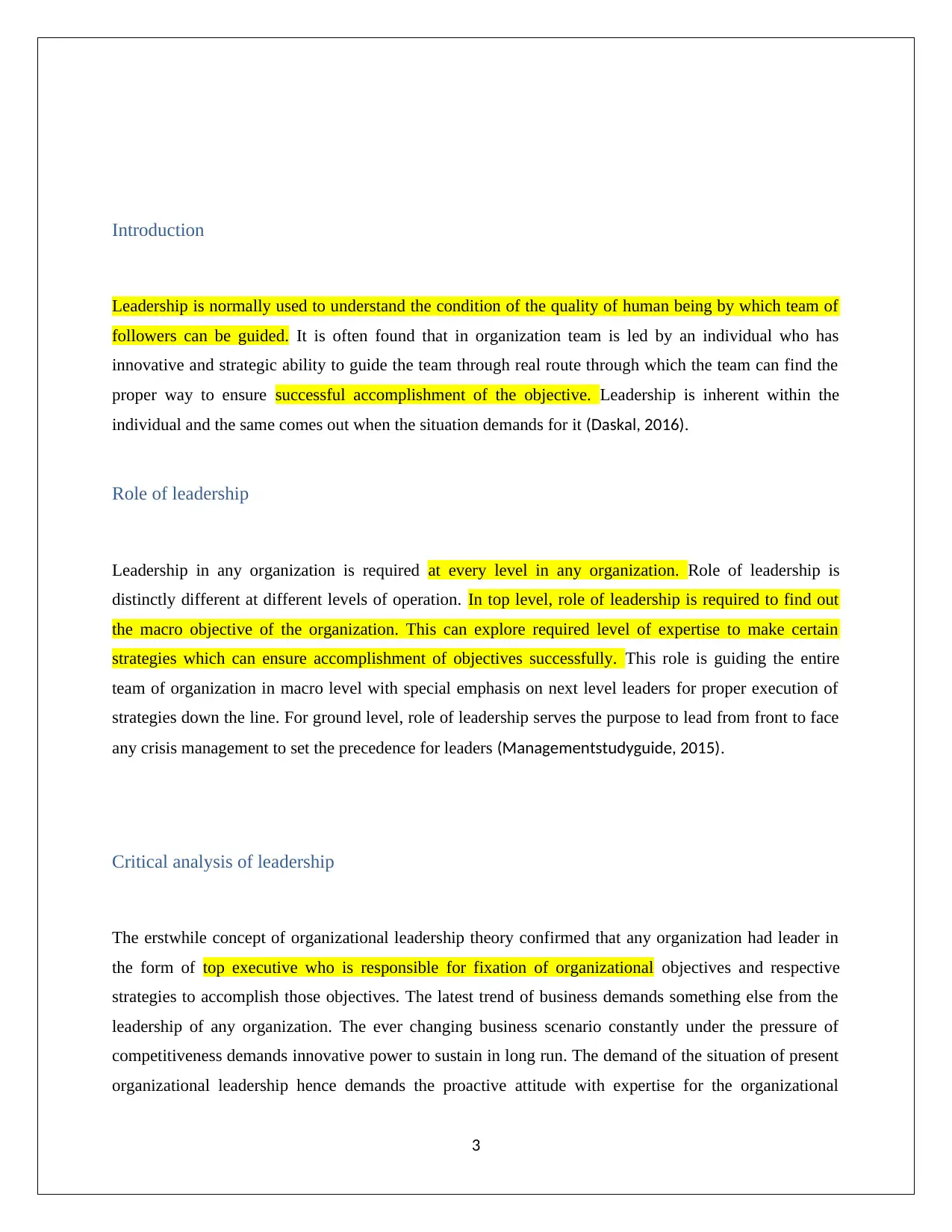
Introduction
Leadership is normally used to understand the condition of the quality of human being by which team of
followers can be guided. It is often found that in organization team is led by an individual who has
innovative and strategic ability to guide the team through real route through which the team can find the
proper way to ensure successful accomplishment of the objective. Leadership is inherent within the
individual and the same comes out when the situation demands for it (Daskal, 2016).
Role of leadership
Leadership in any organization is required at every level in any organization. Role of leadership is
distinctly different at different levels of operation. In top level, role of leadership is required to find out
the macro objective of the organization. This can explore required level of expertise to make certain
strategies which can ensure accomplishment of objectives successfully. This role is guiding the entire
team of organization in macro level with special emphasis on next level leaders for proper execution of
strategies down the line. For ground level, role of leadership serves the purpose to lead from front to face
any crisis management to set the precedence for leaders (Managementstudyguide, 2015).
Critical analysis of leadership
The erstwhile concept of organizational leadership theory confirmed that any organization had leader in
the form of top executive who is responsible for fixation of organizational objectives and respective
strategies to accomplish those objectives. The latest trend of business demands something else from the
leadership of any organization. The ever changing business scenario constantly under the pressure of
competitiveness demands innovative power to sustain in long run. The demand of the situation of present
organizational leadership hence demands the proactive attitude with expertise for the organizational
3
Leadership is normally used to understand the condition of the quality of human being by which team of
followers can be guided. It is often found that in organization team is led by an individual who has
innovative and strategic ability to guide the team through real route through which the team can find the
proper way to ensure successful accomplishment of the objective. Leadership is inherent within the
individual and the same comes out when the situation demands for it (Daskal, 2016).
Role of leadership
Leadership in any organization is required at every level in any organization. Role of leadership is
distinctly different at different levels of operation. In top level, role of leadership is required to find out
the macro objective of the organization. This can explore required level of expertise to make certain
strategies which can ensure accomplishment of objectives successfully. This role is guiding the entire
team of organization in macro level with special emphasis on next level leaders for proper execution of
strategies down the line. For ground level, role of leadership serves the purpose to lead from front to face
any crisis management to set the precedence for leaders (Managementstudyguide, 2015).
Critical analysis of leadership
The erstwhile concept of organizational leadership theory confirmed that any organization had leader in
the form of top executive who is responsible for fixation of organizational objectives and respective
strategies to accomplish those objectives. The latest trend of business demands something else from the
leadership of any organization. The ever changing business scenario constantly under the pressure of
competitiveness demands innovative power to sustain in long run. The demand of the situation of present
organizational leadership hence demands the proactive attitude with expertise for the organizational
3
⊘ This is a preview!⊘
Do you want full access?
Subscribe today to unlock all pages.

Trusted by 1+ million students worldwide
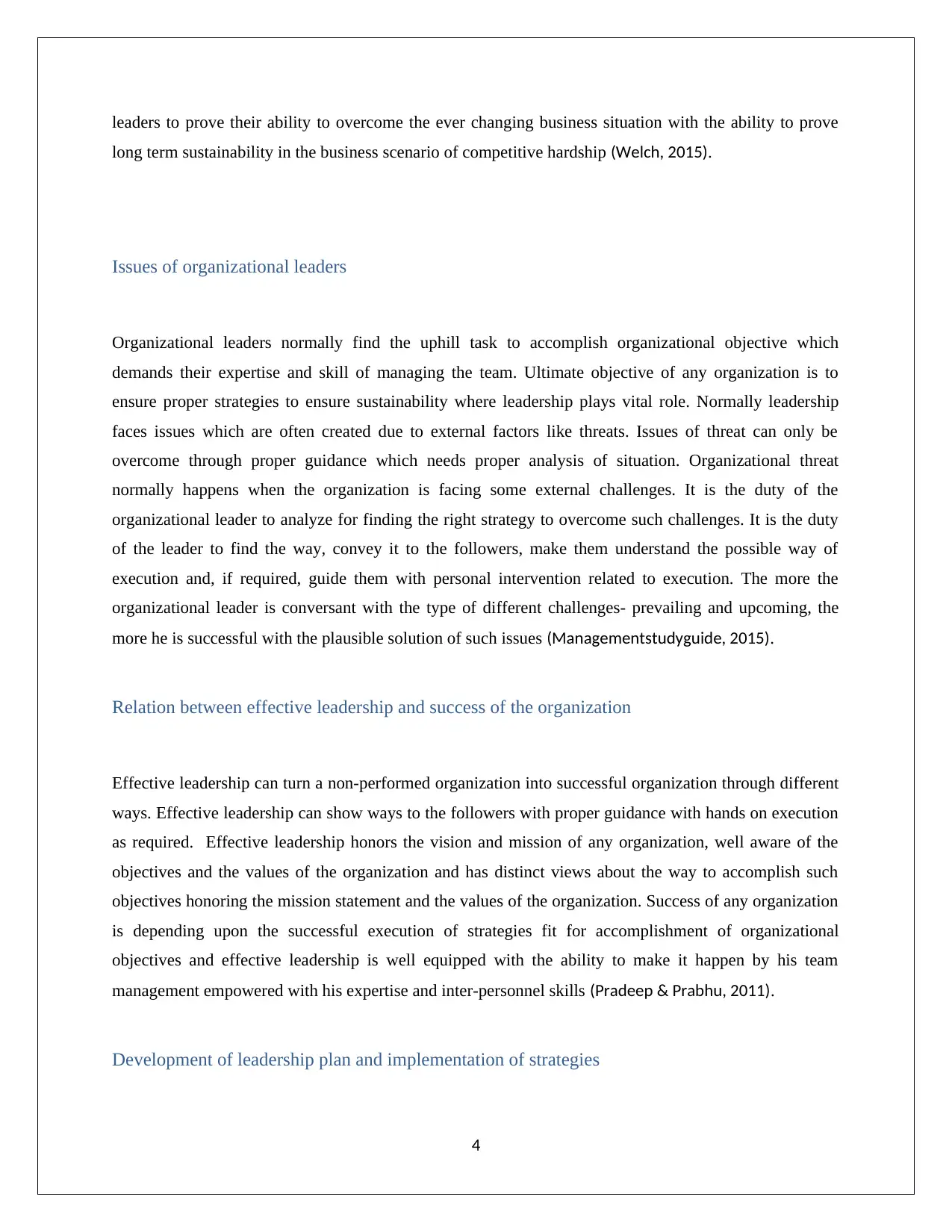
leaders to prove their ability to overcome the ever changing business situation with the ability to prove
long term sustainability in the business scenario of competitive hardship (Welch, 2015).
Issues of organizational leaders
Organizational leaders normally find the uphill task to accomplish organizational objective which
demands their expertise and skill of managing the team. Ultimate objective of any organization is to
ensure proper strategies to ensure sustainability where leadership plays vital role. Normally leadership
faces issues which are often created due to external factors like threats. Issues of threat can only be
overcome through proper guidance which needs proper analysis of situation. Organizational threat
normally happens when the organization is facing some external challenges. It is the duty of the
organizational leader to analyze for finding the right strategy to overcome such challenges. It is the duty
of the leader to find the way, convey it to the followers, make them understand the possible way of
execution and, if required, guide them with personal intervention related to execution. The more the
organizational leader is conversant with the type of different challenges- prevailing and upcoming, the
more he is successful with the plausible solution of such issues (Managementstudyguide, 2015).
Relation between effective leadership and success of the organization
Effective leadership can turn a non-performed organization into successful organization through different
ways. Effective leadership can show ways to the followers with proper guidance with hands on execution
as required. Effective leadership honors the vision and mission of any organization, well aware of the
objectives and the values of the organization and has distinct views about the way to accomplish such
objectives honoring the mission statement and the values of the organization. Success of any organization
is depending upon the successful execution of strategies fit for accomplishment of organizational
objectives and effective leadership is well equipped with the ability to make it happen by his team
management empowered with his expertise and inter-personnel skills (Pradeep & Prabhu, 2011).
Development of leadership plan and implementation of strategies
4
long term sustainability in the business scenario of competitive hardship (Welch, 2015).
Issues of organizational leaders
Organizational leaders normally find the uphill task to accomplish organizational objective which
demands their expertise and skill of managing the team. Ultimate objective of any organization is to
ensure proper strategies to ensure sustainability where leadership plays vital role. Normally leadership
faces issues which are often created due to external factors like threats. Issues of threat can only be
overcome through proper guidance which needs proper analysis of situation. Organizational threat
normally happens when the organization is facing some external challenges. It is the duty of the
organizational leader to analyze for finding the right strategy to overcome such challenges. It is the duty
of the leader to find the way, convey it to the followers, make them understand the possible way of
execution and, if required, guide them with personal intervention related to execution. The more the
organizational leader is conversant with the type of different challenges- prevailing and upcoming, the
more he is successful with the plausible solution of such issues (Managementstudyguide, 2015).
Relation between effective leadership and success of the organization
Effective leadership can turn a non-performed organization into successful organization through different
ways. Effective leadership can show ways to the followers with proper guidance with hands on execution
as required. Effective leadership honors the vision and mission of any organization, well aware of the
objectives and the values of the organization and has distinct views about the way to accomplish such
objectives honoring the mission statement and the values of the organization. Success of any organization
is depending upon the successful execution of strategies fit for accomplishment of organizational
objectives and effective leadership is well equipped with the ability to make it happen by his team
management empowered with his expertise and inter-personnel skills (Pradeep & Prabhu, 2011).
Development of leadership plan and implementation of strategies
4
Paraphrase This Document
Need a fresh take? Get an instant paraphrase of this document with our AI Paraphraser
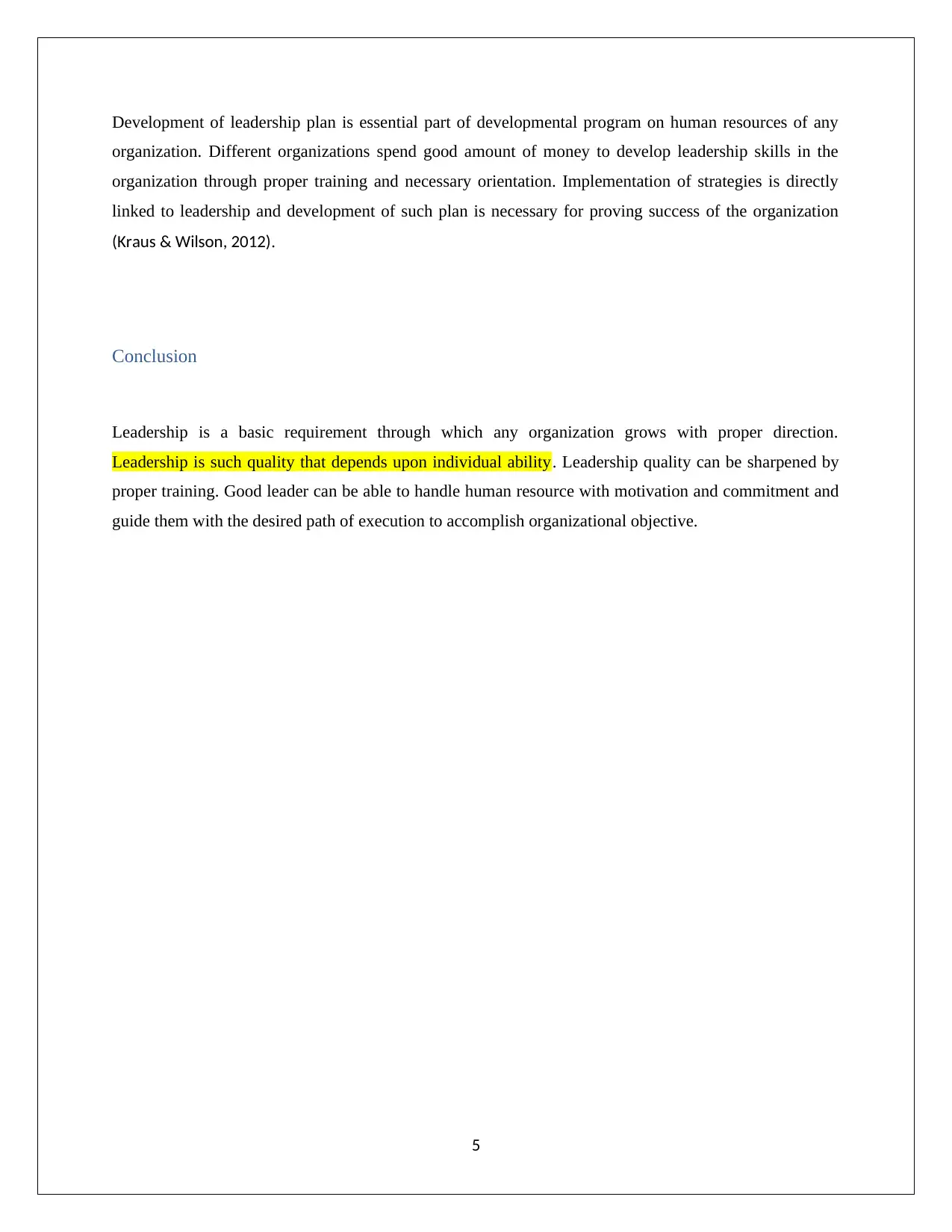
Development of leadership plan is essential part of developmental program on human resources of any
organization. Different organizations spend good amount of money to develop leadership skills in the
organization through proper training and necessary orientation. Implementation of strategies is directly
linked to leadership and development of such plan is necessary for proving success of the organization
(Kraus & Wilson, 2012).
Conclusion
Leadership is a basic requirement through which any organization grows with proper direction.
Leadership is such quality that depends upon individual ability. Leadership quality can be sharpened by
proper training. Good leader can be able to handle human resource with motivation and commitment and
guide them with the desired path of execution to accomplish organizational objective.
5
organization. Different organizations spend good amount of money to develop leadership skills in the
organization through proper training and necessary orientation. Implementation of strategies is directly
linked to leadership and development of such plan is necessary for proving success of the organization
(Kraus & Wilson, 2012).
Conclusion
Leadership is a basic requirement through which any organization grows with proper direction.
Leadership is such quality that depends upon individual ability. Leadership quality can be sharpened by
proper training. Good leader can be able to handle human resource with motivation and commitment and
guide them with the desired path of execution to accomplish organizational objective.
5
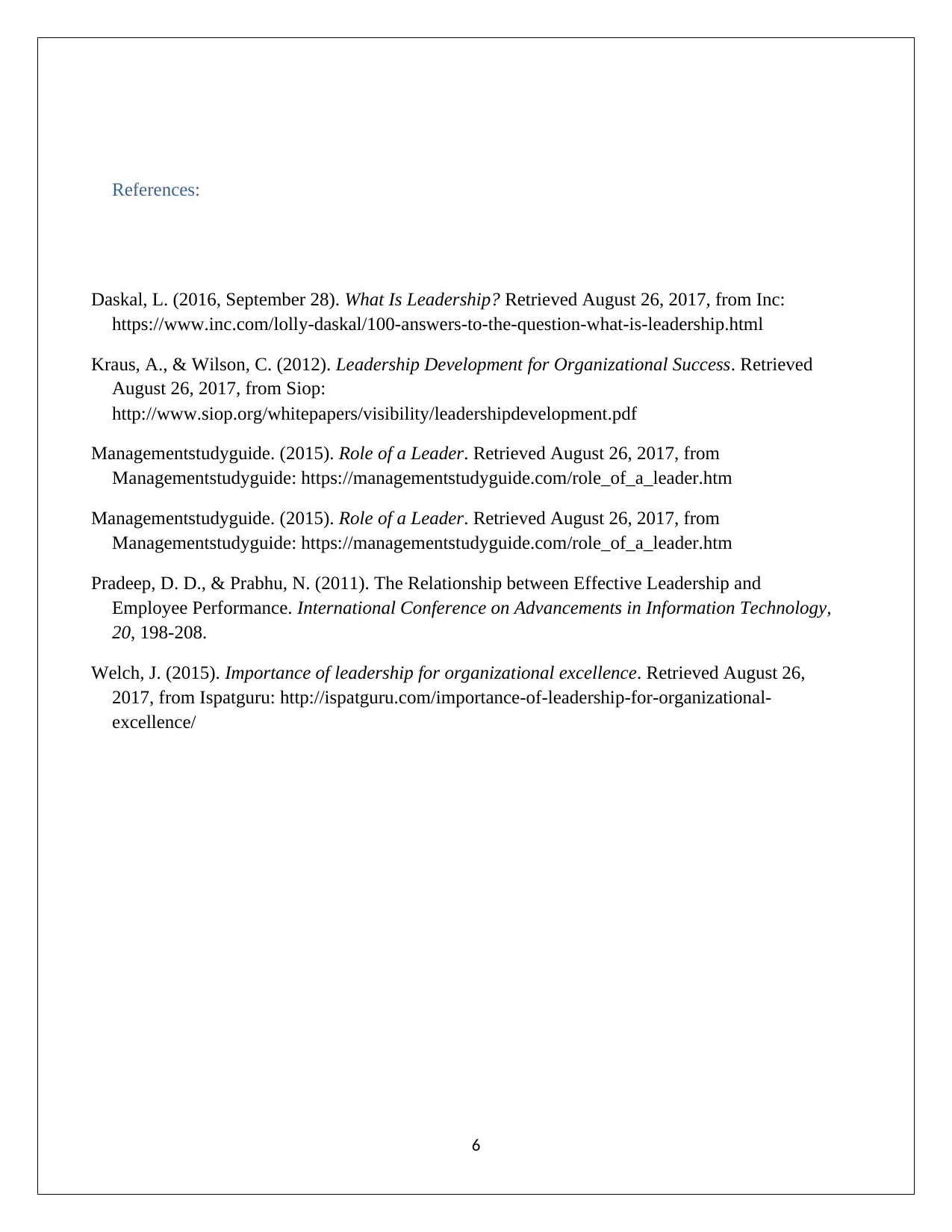
References:
Daskal, L. (2016, September 28). What Is Leadership? Retrieved August 26, 2017, from Inc:
https://www.inc.com/lolly-daskal/100-answers-to-the-question-what-is-leadership.html
Kraus, A., & Wilson, C. (2012). Leadership Development for Organizational Success. Retrieved
August 26, 2017, from Siop:
http://www.siop.org/whitepapers/visibility/leadershipdevelopment.pdf
Managementstudyguide. (2015). Role of a Leader. Retrieved August 26, 2017, from
Managementstudyguide: https://managementstudyguide.com/role_of_a_leader.htm
Managementstudyguide. (2015). Role of a Leader. Retrieved August 26, 2017, from
Managementstudyguide: https://managementstudyguide.com/role_of_a_leader.htm
Pradeep, D. D., & Prabhu, N. (2011). The Relationship between Effective Leadership and
Employee Performance. International Conference on Advancements in Information Technology,
20, 198-208.
Welch, J. (2015). Importance of leadership for organizational excellence. Retrieved August 26,
2017, from Ispatguru: http://ispatguru.com/importance-of-leadership-for-organizational-
excellence/
6
Daskal, L. (2016, September 28). What Is Leadership? Retrieved August 26, 2017, from Inc:
https://www.inc.com/lolly-daskal/100-answers-to-the-question-what-is-leadership.html
Kraus, A., & Wilson, C. (2012). Leadership Development for Organizational Success. Retrieved
August 26, 2017, from Siop:
http://www.siop.org/whitepapers/visibility/leadershipdevelopment.pdf
Managementstudyguide. (2015). Role of a Leader. Retrieved August 26, 2017, from
Managementstudyguide: https://managementstudyguide.com/role_of_a_leader.htm
Managementstudyguide. (2015). Role of a Leader. Retrieved August 26, 2017, from
Managementstudyguide: https://managementstudyguide.com/role_of_a_leader.htm
Pradeep, D. D., & Prabhu, N. (2011). The Relationship between Effective Leadership and
Employee Performance. International Conference on Advancements in Information Technology,
20, 198-208.
Welch, J. (2015). Importance of leadership for organizational excellence. Retrieved August 26,
2017, from Ispatguru: http://ispatguru.com/importance-of-leadership-for-organizational-
excellence/
6
⊘ This is a preview!⊘
Do you want full access?
Subscribe today to unlock all pages.

Trusted by 1+ million students worldwide
1 out of 6
Related Documents
Your All-in-One AI-Powered Toolkit for Academic Success.
+13062052269
info@desklib.com
Available 24*7 on WhatsApp / Email
![[object Object]](/_next/static/media/star-bottom.7253800d.svg)
Unlock your academic potential
Copyright © 2020–2025 A2Z Services. All Rights Reserved. Developed and managed by ZUCOL.





